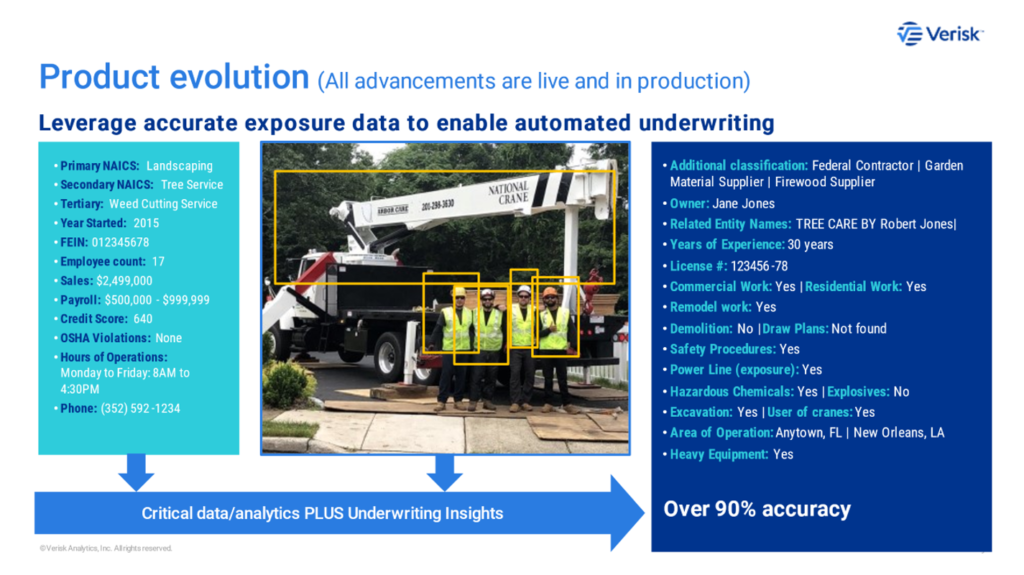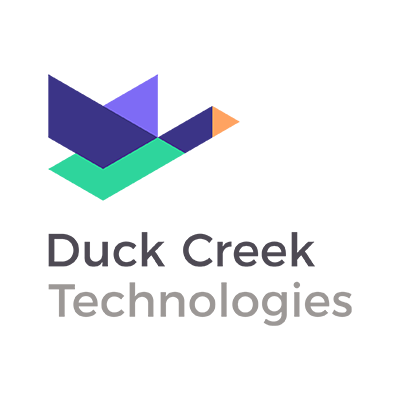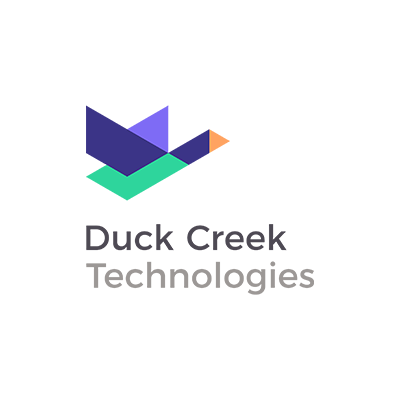On a previous episode of Conversations on the Creek, Rob Savitsky and Robert Fletcher of Duck Creek discussed the ins and outs of underwriting small commercial risks, and the impact of data informing better outcomes for carriers. In the short time since that discussion, new tech innovations and advances with data have created new opportunities for insurance carriers.
Recently, we were able to sit down with Elizabeth Casas, VP and Head of Commercial Lines Underwriting, and Othman Loudghiri, Director of Small Commercial and Casualty at Verisk to learn more about the advances in small commercial underwriting from straightforward data prefill capabilities to providing comprehensive insights for a fully automated process. Insights are derived from a wide variety of datasets (structured and unstructured) leveraging AI/ML capabilities. These insights include information about the business, industry specific hazards and exposures, property and neighborhood.
Here are some highlights from our conversation.
Q: What are some recent trends impacting the underwriting of small commercial property?
Loudghiri: “The most important trend in the small commercial space is the steady increase in opportunity. The market continues to grow, but with such a fragmented market, the insurers with access to the most accurate data needed for underwriting and faster quote times are poised to capitalize. It is estimated that 40% of small businesses don’t currently carry insurance, creating upwards of $60 billion in opportunity. What’s more, small businesses are 94% likely to stick with their insurer. These factors add to a growing, profitable, and untapped market.”
Q: What are the challenges facing underwriters when it comes to providing insurance quotes for small businesses?
Loudghiri: There are a number of challenges insurers encounter with small business quotes. First, traditional processes require underwriters to ask too many application questions of small businesses. And based on the information provided, they may have limited visibility to the full risk, which can result in under or over-insurance for the business and premium leakage for the carrier.
Most notably, it is difficult to find quality data that provides trustworthy actionable insights for underwriters. Slow turn times may cause agents to look elsewhere, losing the insurer business before they can complete the underwriting process and provide a quote. It is clear that having only the data essential to the underwriter be accurate and quickly available creates a more positive experience for everyone. Indeed, getting to a point where the insurer is able to provide the first quote (which is often best quote) for policies with low complexity risks quickly becomes an essential objective.
Q: One trend you’ve discussed previously is “the race to zero,” prefill data along with actionable insights based on the type of risk to minimize the number of questions needed for a small business to get a quote for a business owner’s policy. How does this provide a more personalized experiences to small businesses?
Loudghiri: The business owner’s experience will be streamlined from the start, immediately creating a more personalized and efficient process. By prefilling data and delivering insights needed to underwrite a policy, quote times are drastically reduced, thereby reducing friction in the process. Personalization is also enhanced simply by eliminating the process of completing a lengthy questionnaire, saving time and frustration for both the insurer and insured.
With the Duck Creek integration with Verisk Lightspeed Small Commercial, the small business owner gets personalization and a policy that meets their needs. With just a business name and address, this integration provides prefill data, business firmographics, and actionable insights using unstructured data and image analytics through AI and ML technology. Thus, these capabilities go beyond the standard prefill data capabilities.

Q: What techniques are used by leading data providers to ensure the data being prefilled is accurate and provides small businesses the rates they deserve?
Loudghiri: You can have the fastest quoting times, but your underwriting and rating rules are only as good as the data you feed them. This makes having seamless access to reliable data arguably the most important aspect of your small business underwriting operation.
At Verisk, we have a number of solutions and processes in place to ensure we provide the highest quality data without compromising speed or compliance.
First, we test our data models frequently. To be effective, testing must be iterative and conducted on up-to-date data, since what’s considered predictive information is continuously evolving. Secondly, we have insurance expertise; Our data science experts test assumptions and examine outputs for credibility and applicability. These experts can provide guidance on what data points are more relevant to ratemaking or premium and claims-driving risk characteristics. Lastly, our teams are constantly monitoring legal, regulatory, and legislative developments in all the states where our customers write business, ensuring they stay compliant and never compromise coverage for their customers.
Q: Property exposure risks have changed during the pandemic. How frequently are these changes in the building data being captured so that it can be operationalized in their core system workflows?
Casas: Verisk updates our pricing data monthly. Calculating replacement costs with monthly data means prices are more likely to reflect current market realities. Frequent pricing updates can flatten the curve of potential spikes, resulting in fewer surprises for carriers quoting policies and property owners applying for insurance.
Underwriters can count on Verisk 360Value to accurately estimate replacement costs because the data is based on actual claims information. 360 Value can be accessed as a standalone product or solution and is available in LightSpeed Small Commercial for BOP policies.
Q: Looking ahead, what are future data sources the insurance industry will be able to leverage to personalize the underwriting experience for small businesses further?
Casas: We believe that we will see the continued expansion into the world of unstructured data, such as images, videos, and text. With solutions like LightSpeed and other underwriting intelligence solutions integrated with core systems, we can provide more actionable insights to the carrier. This data, paired with the traditional data resources, will enable us to provide a more holistic view of the business and empower underwriters with the information they need to excel in their work.
The Duck Creek-Verisk Solution
Having reliable data and a flexible, modern policy administration system is critical to providing customers with the personalized experience they deserve while also maximizing operational efficiency. With Duck Creek’s latest integration with Verisk, everyone is a winner. Small businesses can quickly and easily get quoted for the coverage they need, and you, the insurer, can automate the majority of your BOP book, freeing up your underwriters for the more complex risks.





